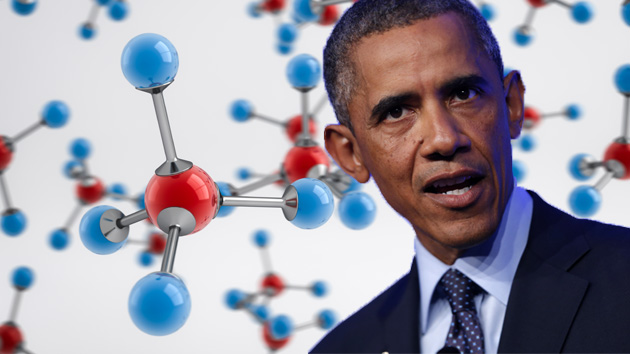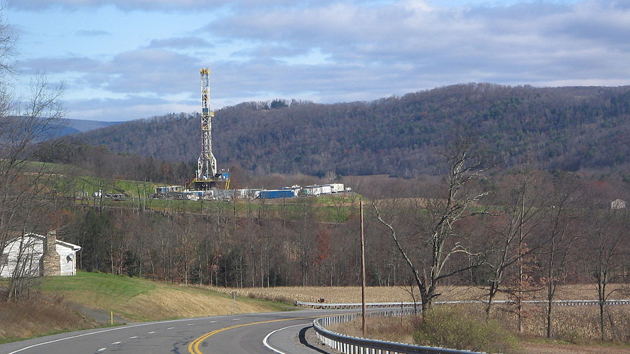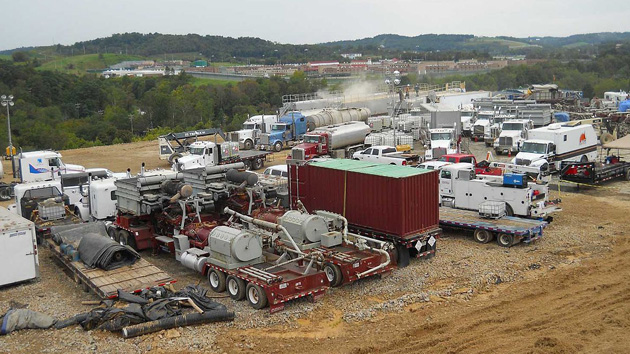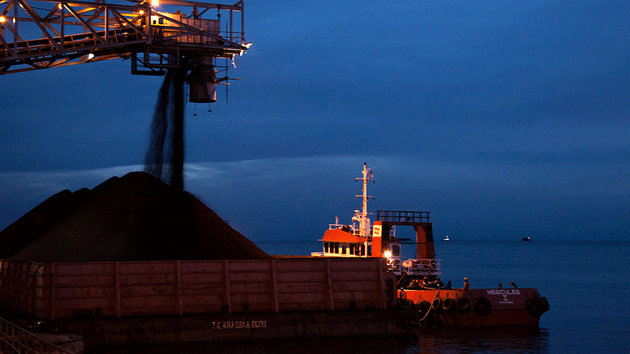
Obama: Charles Dharapak/AP; Methane: <a href="http://www.shutterstock.com/gallery-295297p1.html">Michelangelus</a>/Shutterstock
If you’re a politician, science is a bitch; it resists spin. And a new set of studies—about, of all things, a simple molecule known as CH4—show that President Obama’s climate change strategy is starting to unravel even as it’s being knit. To be specific: Most of the administration’s theoretical gains in the fight against global warming have come from substituting natural gas for coal. But it looks now as if that doesn’t really help.
In a very real sense it’s not entirely the president’s fault. When Obama took office in 2008 he decided to deal with health care before climate change, in essence tackling the biggest remaining problem of the 20th century before teeing up the biggest challenge of the 21st. His team told environmentalists that they wouldn’t be talking about global warming, focusing instead on “green jobs.” Obama did seize the opportunity offered by the auto industry bailout to demand higher mileage standards—a useful move, but one that will pay off slowly over the decades. Other than that, faced with a hostile Congress, he spent no political capital on climate.
But he was able nonetheless to claim a victory of sorts. His accession to office coincided (coincidentally) with the widespread adoption of hydraulic fracking to drill for natural gas, resulting in a sudden boom in supplies and a rapid drop in price, to the point where gas began to supplant coal as the fuel of choice for American power plants. As a result (and as a result of the recession Obama also inherited), the nation’s carbon dioxide emissions began to fall modestly.
For a political leader, it was the very definition of a lucky break: Without having to do much heavy lifting against the power of the fossil fuel industry, the administration was able to produce results. In fact, it gave Obama cover from the right, as he in essence turned the GOP chant of “Drill Baby Drill” into “Frack Baby Frack.” Not only that, the cheap gas was a boost to sputtering American manufacturing, making it profitable once again to make chemicals and other goods close to home. As Obama said in his 2012 State of the Union address, as his reelection campaign geared up, “We have a supply of natural gas that can last America nearly a hundred years, and my administration will take every possible action to safely develop this energy.”
In his second term, Obama has become more vocal about climate change—and even more explicit in his reliance on natural gas to make the numbers work. Here’s the State of the Union 2014: “If extracted safely, it’s the bridge fuel that can power our economy with less of the carbon pollution that causes climate change.”
Shortly after that speech, the president announced his most ambitious climate plans yet, instructing the Environmental Protection Agency to regulate carbon emissions from power plants, with the goal of cutting 30 percent from 2005 levels by 2030. This attack on coal was welcome news for those of us concerned with climate change, because it marked the first time (and given his approaching lame-duck status, probably the last) the president had really taken on the issue with actual laws. It was, among other things, an (apparently successful) effort to get countries like China making commitments of their own, and to restart the international negotiations that failed at Copenhagen in 2009.
Whether that strategy pays off or not, one key result is not in doubt: As Forbes magazine pointed out that day, the EPA regulations will lead to “the dramatic expansion of natural gas as a fuel for power generation.” Some sun, some wind, but an awful lot of gas. In fact, the administration is so bullish on fracked gas that it is both moving to export more of our supply to other nations (it’s even been suggested as a way to stand up to Vladimir Putin) and offering many countries technical assistance in learning how to frack on their own. A long list, including India, China, Indonesia, South Africa, and Mexico have taken up the State Department on the offer.
Much of the new gas that fracking made profitable was found beneath the Marcellus Shale, a huge formation that runs beneath the Appalachians as far north as upstate New York. Fracking and drilling for gas in this densely populated region was different than doing it in Texas or the Dakotas—people quickly began to notice, and complain. Grassroots opposition to fracking mushroomed, finding its voice in director Josh Fox’s provocative documentary Gasland, and its iconic image of a faucet shooting flame.
But because the gas industry had a head start on its critics, and was willing to spend huge sums to influence local and state politicians, fracking was soon firmly ensconced in places like Pennsylvania, which was even leasing state forest land for drilling. The opposition barely managed to draw a line at the New York border, convincing Gov. Andrew Cuomo that it would be politically unwise to lift a moratorium on the practice.
Given the geology—and the intellectual geography—of upstate New York, it was no surprise that Ithaca became a center of the debate—and that the swirling debate began to interest faculty at some of the local institutions: Ithaca College’s Sandra Steingraber, for instance, and some of Cornell’s best scientists. Among them was Bob Howarth, a biogeochemist who began to wonder about the larger implications of the fracking boom.
And here’s where we need to talk chemistry for a minute. Carbon dioxide—CO2, the molecule produced when we burn fossil fuels—traps heat in the atmosphere, causing much of the climate change we see around us. The reason President Obama likes gas more than coal is because it produces half as much carbon dioxide when you burn it.
But CO2 is not the only molecule that plays this trick. Methane—CH4—is a rarer gas, but it’s even more effective at trapping heat. And methane is another word for natural gas. So: When you frack, some of that gas leaks out into the atmosphere. If enough of it leaks out before you can get it to a power plant and burn it, then it’s no better, in climate terms, than burning coal. If enough of it leaks, America’s substitution of gas for coal is in fact not slowing global warming.
Howarth’s question, then, was: How much methane does escape? “It’s a hard physical task to keep it from leaking—that was my starting point,” he says. “Gas is inherently slippery stuff. I’ve done a lot of gas chromatography over the years, where we compress hydrogen and other gases to run the equipment, and it’s just plain impossible to suppress all the leaks. And my wife, who was the supervisor of our little town here, figured out that 20 percent of the town’s water was leaking away through various holes. It turns out that’s true of most towns. That’s because fluids are hard to keep under control, and gases are leakier than water by a large margin.”
Howarth and his colleague Anthony Ingraffea began to investigate. In a paper published in the journal Climate Change in May 2011, they concluded that somewhere between 3.6 percent and 7.9 percent of the methane from fracking wells was escaping into the atmosphere as its made its way from underground to end user. Which is a lot. More than enough, as we shall see, to make fracking worse for climate change than the coal it was replacing.
The attacks began immediately, in the time-honored tradition dating back at least to the time of Rachel Carson. Industry newspapers proclaimed that the Cornell researchers were “junk scientists” and “activists.” As the editor of the trade paper Marcellus Drilling News put it, “the only fugitive methane of any significance is the stuff emanating from these two.”
Other researchers also went to work trying to disprove Howarth and Ingraffea’s hypothesis. Some of the research found lower rates of leakage—though the lowest estimates tended to come from estimates provided by industry, or from examinations of the best-performing wells. Some of the research found much higher rates of leakage—these tended to be from teams flying airplanes over fracking fields and actually measuring how much of the gas was in the atmosphere, and it’s likely they focused their flights on worse-than-average wells.
Over time, academic research has done what its supposed to do, providing an ever-narrower range of numbers. In April, Howarth published a review of all the data sets so far, and they showed that his original numbers were pretty likely correct: Up to 5 percent of the methane probably leaks out before the gas is finally burned.
Why exactly it leaks is unclear. New research, some of it involving Howarth but led by chemists at Purdue University, seems to show that drills can open up gas pockets even before they reach their target in the shale, and that this can send big plumes of methane into the atmosphere. A Canadian panel that evaluated fracking focused, among other things, on the difficulty of effectively sealing wells with cement around the drill pipe, both during production and once they’re abandoned.
“It sounds like it ought to be simple to make a good cement seal,” says Naomi Oreskes, a Harvard professor who served on the Canadian team. “It seems like it should be trivial, but the phrase we finally fixed on is ‘an unresolved engineering challenge.’ The technical problem is that when you pour cement into a well and it solidifies, it shrinks. You can get gaps in the cement.” As she point out, “all wells leak. Water wells leak. We’ve drilled millions of wells in North America, and all that time we’ve never figured it out.”
Many of the people who are trying to figure it out work at the Environmental Defense Fund (EDF), an environmental group with close ties to industry. They have sponsored a series of studies to find both the source of the problem and to suggest ways that the leaks can be plugged. “It’s not a particular piece of equipment, and it’s not a particular company, big or small. It’s somewhat randomly distributed, which suggests human factors are a big element,” says EDF associate vice president Mark Brownstein.
EDF is convinced that with tight regulation and constant monitoring and inspection, about 40 percent of the leakage can be inexpensively controlled: about a penny per thousand cubic feet of gas, says the group’s chief scientist, Steve Hamburg. Federal rules requiring “green completion” of fracked wells will go into effect next year, a step Howarth applauds—though he and others note that enforcement will be largely left to state officials, who often lack both the budget and the zeal to stand up to the fossil fuel industry.
Still, with “unprecedented investment in natural gas infrastructure and regulatory oversight,” says Howarth, you might be able to cut leakage in half. And if so, using natural gas rather than coal to generate electricity “might result in a very modest reduction in total greenhouse gas emissions.”
Given the news from the South Pole this spring—that the West Antarctic Ice Sheet is showing signs of “irrevocable” melt—”very modest reductions” in emissions sounds less than comforting. But in fact the situation is probably worse than that. We need to look beyond methane leakage for a moment, and think about the transition to gas in a larger context. Because if we’re replacing coal with gas, it means we’re not replacing it with something else.
That something else is carbon-free energy. In the official Obama story (one being echoed in Hillary Clinton’s climate talking points), natural gas is a “bridge” to a world of solar and wind power, which isn’t quite ready yet. But in fact, in just the same years that we’ve learned to frack we’ve also learned an awful lot about how to scale up wind and sun. And that means that far from being a bridge, the big investments in natural gas may actually be a breakwater that keeps this new wave of truly clean energy from washing onto our shores.
The advances in renewable technology have been, in fact, staggering. Here’s EDF president Fred Krupp: “We talk a lot how been there’s a 99 percent drop in the price of solar panels over the last 40 years. But the really remarkable thing is that 75 percent of that has come since 2008. It’s completely amazing.” And in the few places that have taken full advantage of the new technologies, the results have been astonishing.
There have been days in Germany this summer when 75 percent of the electricity has come from solar panels; in the winter, there are days when wind power provides nearly as much. Overall, the Germans think that within the decade, they may get more than half of their total energy from renewables. And in Rick Perry’s Texas, there were days this spring when a third of the state’s electricity came from wind power.
None of this means that the obstacles to deployment have disappeared: Though storage of electricity in batteries big and small is suddenly getting much easier (and we’re discovering other ways, like compressed air, to store power), it remains a problem, as does an outdated grid. But more of the obstacles have to do with regulation and vested interest: “We need to clear away a bunch of the dumb rules that states have in place that block this path,” as Krupp puts it.
But that won’t get at the other big factor slowing growth in renewable energy: the sudden rise in cheap shale gas. Even as the price of solar panels has dropped, inexpensive fracked gas reduces the incentives to convert to sun and wind. And once you’ve built the pipelines and gas-fired power plants, the sunk investment makes it that much harder to switch: Suddenly you have a bunch of gas barons who will fight as hard as the coal barons Obama is now trying to subdue.
As it turns out, economists have studied the dynamics of this transition, and each time reached the same conclusion. Because gas undercuts wind and sun just as much as it undercuts coal, there’s no net climate benefit in switching to it. For instance, the venerable International Energy Agency in 2011 concluded that a large-scale shift to gas would “muscle out” low-carbon fuels and still result in raising the globe’s temperatures 3.5 degrees Celsius—75 percent above the two-degree level that the world’s governments have identified as the disaster line. The head of the United Nations’ environment program, Achem Steiner, said earlier this year that the development of shale gas would be “a liability” in fighting global warming if “it turns into a 20-to-30-year delay” for low-and zero-carbon models.
Energy expert Michael Levi at the Council on Foreign Relations has found that if we wanted to meet that two-degree target (and since just one degree is already causing havoc, we sure should), global gas consumption would have to peak as early as 2020. Which is, in infrastructure terms, right about now—if we want to be moving past natural gas by 2020, we need to stop investing in it now.
The biggest single modeling exercise on this issue was carried out at Stanford in 2013, when teams from 14 companies, government agencies, and universities combined forces. They concluded that, in the words of analyst Joe Romm, “from a climate perspective the shale gas revolution is essentially irrelevant—and arguably a massive diversion of resources and money that could have gone into carbon-free sources.” And that study didn’t even look at the impact of leaking methane.
With shale, as with many other things, we rushed ahead before we’d fully figured out the science and economics. But now that the analysis has had time to mature, several things are easily apparent:
1. Given what we know about methane leakage, it makes absolutely no sense to convert vehicle fleets to natural gas. That’s because, as you go from the well to the car, there are even more places for leaks than when you send the gas to a power plant. An EDF study found that converting even big diesel trucks to natural gas would result “in nearly 300 years of climate damage before any benefits were achieved.” Since we already use gas for lots of things like home heating and cooking, there should be a huge priority on plugging the leaks in the ancient pipes that deliver it to our cities, and in converting home gas furnaces to more modern technology like heat pumps.
2. It also makes no sense to export natural gas around the world. This is a live issue: Protesters rallied this month at Cove Point in Maryland, site of one of many new proposed terminals for exporting liquefied natural gas from US shale. If they all get built, our exports will grow 14-fold by 2020. Such plans, because they will make big money, have powerful backers: When Heather Zichal left her post as the Obama administration’s climate czar, she accepted a $180,000-a-year position on the board of the country’s biggest gas exporter.
But the math doesn’t work at all. When you chill and rewarm natural gas for shipping, leaks multiply. A study this spring from the Department of Energy—even using leak rates we now know to be too conservative—found that shipping natural gas to China and burning it instead of coal would mean no improvement for the climate.
3. The Obama administration plan to help other countries develop shale gas likely makes no sense either. If the best one can hope for in this country, after intensive efforts at regulation and enforcement, is a barely marginal improvement over coal, then even that gain is unlikely in countries where environmental enforcement is nonexistent. You can make a case in places like China and India, where the public health effects of coal smoke are so terrible, that gas is better even if it’s not helping the climate—but these are also precisely the places poised to make huge advances in renewables.
4. Most contentiously, environmentalists in the United States should all be doing what they can to slow the spread of fracking. As the science has mounted, this has been the trend: The nation’s biggest environmental group, the Sierra Club, went from accepting major contributions from the nation’s biggest gas developer to turning down that money and vocally opposing increased fracking. EDF is the main group that hasn’t come out in favor of moratoriums in places like New York, instead working with industry to come up with new regulations and saying it’s up to local communities to decide whether they want to frack.
To be sure, Krupp, EDF’s leader, talks about gas as “an exit ramp,” not a bridge, and in a debate this spring said it was imperative to avoid “lock-in” to the fuel. Still, EDF’s work with industry angers many anti-fracking activists, who feel that it will help expand the practice: When Krupp and former New York City Mayor Michael Bloomberg called for new fracking regulations in a New York Times op-ed earlier this year, gas producers (who realize that such rules will help reduce opposition to the practice) cheered it. Efforts to regulate existing wells would be more useful if EDF were to also come out against an expansion of fracking: We will, after all, continue to produce natural gas in this country (if nothing else, massive quantities are required to produce fertilizer) and there is no need to leak more methane than we have.
The importance of this debate has grown the more we’ve learned about methane—and one of the things we’ve learned is how fast it acts. Unlike CO2, which can last in the atmosphere for a century or more, methane disappears relatively quickly. Which means that its power at trapping heat is concentrated in a very short burst.
Twenty years ago, when scientists first started calculating how much to worry about methane, they said that molecule for molecule, it trapped 25 times as much solar radiation as CO2. But now, over a more appropriate 20-year time frame, that ratio is reckoned to be about 86 times as much. At that rate, more than a third of the greenhouse gas that America produces is methane (not all of it from gas wells—a fair amount comes from cattle). And that means that while the Obama administration boasts about cutting carbon, it’s poised to leave behind a huge burst of methane as its greatest climate legacy.
It turns out, in other words, that there’s no easy bridge to a working climate future—no way to avoid angering powerful interests, no way to put off actually building the clean energy we desperately need. It’s time to stop searching for a bridge and simply take the leap.
















